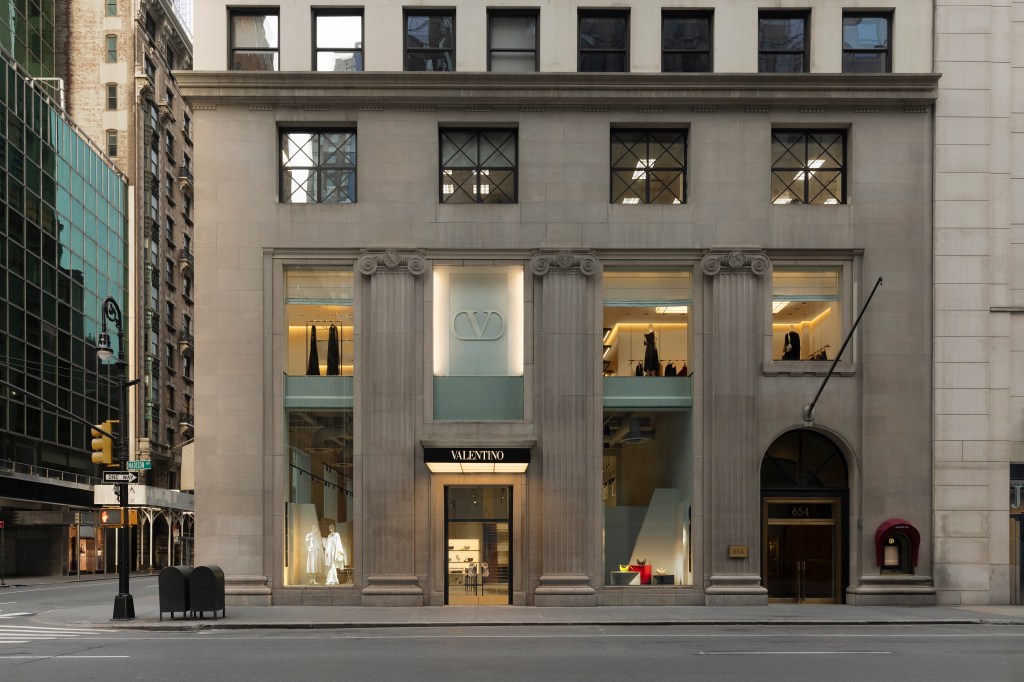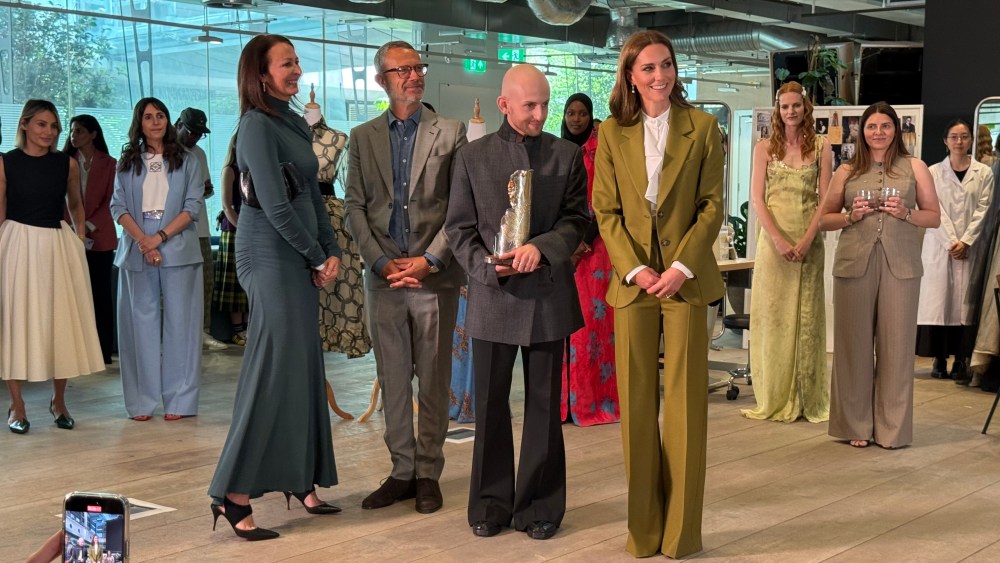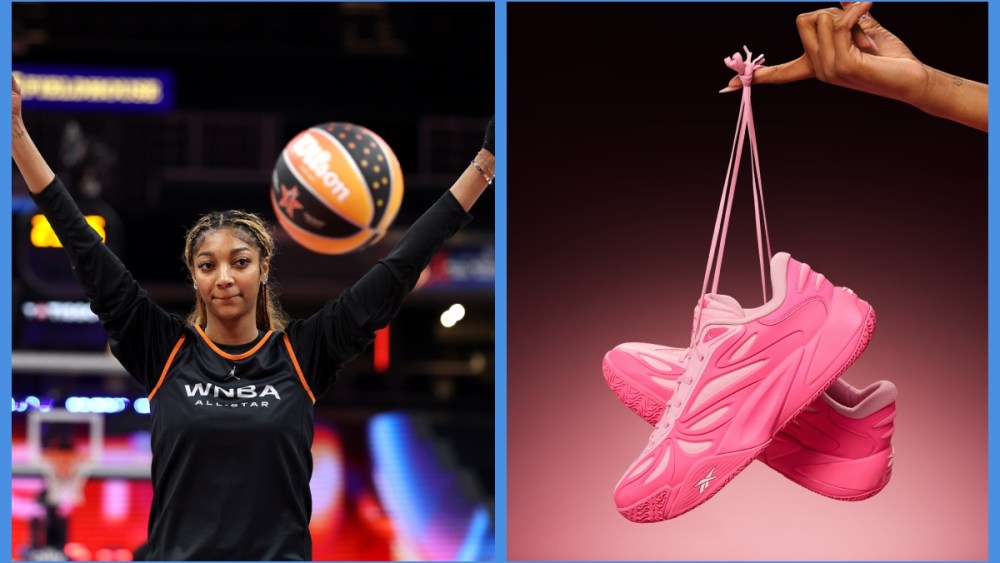MILAN – The building housing the new Valentino flagship on 654 Madison Avenue “is a perfect synthesis of the best architecture in New York,” believes creative director Pierpaolo Piccioli, and is “an experience in itself.”
The store in the storied building — it previously was home to Calvin Klein’s iconic Manhattan flagship designed by John Pawson — opens to the public Wednesday and is based on Valentino’s new global retail concept, established last year in-house, directly by Piccioli and his team. But the designer said that for the New York store, he let himself “be led and inspired by the Genius Loci, the spirit of the location,” with its “permanent signs that allow you to recognize [it as]something already known to memory,” he contended. “There is a tangible familiarity that makes New York a bit of a special place for everyone, also for those who have not visited it yet.”
The flagship marks an important strategic moment for Valentino’s retail approach worldwide, after the opening of boutiques in Florence and Paris last June, followed by Shanghai at Plaza 66 a month later, among others.
“Our intention is to bring Valentino around the world,” said Piccioli, while respecting each location. “It is undeniable that every location is unique, and in particular in Madison we let the interiors determine the path we should take. I like to interact with the locations, to create an exchange based on respect and curiosity,” he continued. “I like to think that opening a store can also have a cultural value that is every time a possibility to bring who we are into the world.”
The New York unit also reflects Valentino’s development since the arrival of chief executive officer Jacopo Venturini in June 2020, who worked with Piccioli on repositioning the brand as a couture house. This strategy is exemplified by the Madison Avenue flagship, said the executive, “with the goal to raise the values that characterize us in a strategic way in the city.”
North America accounts for 20 percent of global retail sales through directly operated stores. Taking wholesale and non-DOS into account, the weight is of around 25 percent.
As per the latest figures available reported in April, in the 12 months ended Dec. 31, sales at the Rome-based couture house reached 1.42 billion euros, climbing 15 percent compared with 1.23 billion euros in 2021. Venturini has been rebalancing wholesale versus retail by increasingly reducing the wholesale activity “to focus only on working with selected partners that reflect our brand values and sustain our business strategy and vision,” explained Venturini at the time.

Directly operated retail generated 62 percent of sales in 2022 compared to 54 percent in 2019. The goal is for that channel to represent 80 percent of the total by 2025 or 2026.
Valentino’s SoHo boutique in Manhattan will reopen by the end of 2023, said Venturini.
There are 30 Valentino directly operated stores and 27 doors in the U.S. The company is not forsaking wholesale entirely and in the U.S. it works with department stores including Saks Fifth Avenue, Bergdorf Goodman, Neiman Marcus, Nordstrom and Bloomingdale’s.
“Madison Avenue is a key location renowned around the world, which attracts local and international customers,” said Venturini. “We will offer an experiential, tailored and client-centric journey that also includes two VIP areas.”
Asked about the American consumer, Piccioli said that he would “rather think of people, and rather than a geographic area, think of a community.” Valentino’s customers, he said, “are people who choose to embrace a vision that is certainly communicated through a precise aesthetic but that draws strength also from sharing the same values.” There will be specific experiences that include capsule collections, “but all integrated and narrated through the same, shared sentiment.”
Set over three stories that include basement, ground floor, a mezzanine and a second floor, the nearly 12,333-square-foot’s store facade is marked by imposing columns and tall windows.
The building is monumental with ceilings as high as 23 feet, exposed steel columns running across all floors and a rough concrete finish over the perimeter punctuated by illuminated shelving for Valentino Garavani accessories.

Each floor hinges on a distinctive visual narrative based on chromatic compositions and carefully curated materials and palettes, including Valentino’s signature red, rendered in several different iterations.
There is a striking contrast between rationalist architecture and warmer, cocooning spaces. Piccioli explained that, since concrete is a significant part of the construction, materials were a key focus, “integrating marbles and tracing the spaces almost in an intangible way through structures that, in addition to being useful as displays, also create thematic areas but in a fluid way, rather than schematic.”
The building’s mezzanine is a concrete box facing the boutique’s ground floor on one side and it will be dedicated to temporary art displays, debuting through a partnership with New York museum Magazzino Italian Art, presenting five large-scale paintings by Mario Schifano. This collaboration strengthens Valentino’s ongoing commitment to global art and visual culture and pays tribute to contemporary Italian painting.

“The idea of an artistic experience in the store is in sync with our intention to offer a welcoming location which will communicate the values of the brand, maximizing the opportunities that the location offers,” said Piccioli. The designer said that bringing Schifano to New York allows the brand to showcase one of the main artists in the world — from Rome, to boot, where Valentino is headquartered — “conceptually summarizing the way Valentino can be perceived in the world.”
With Magazzino Italian Art, Valentino will collaborate on a series of exhibitions featuring works by renowned Italian artists and talks will be hosted in the new store in the coming months, promoting cross-cultural dialogue. Magazzino has unveiled the new Robert Olnick Pavilion and the collaboration with Valentino is an extension of the exhibition “Mario Schifano: The Rise of the ‘60s”, currently on view at the museum in Cold Spring, N.Y.
Over the years the Valentino on Canvas projects have shined a light on contemporary and emerging painters and sculptors. In Shanghai and Beijing in 2020 and 2021, the house staged two physical experiences, “Re-signify Parts I and II,” where the codes of the fashion house were interpreted by and presented alongside contemporary art and visual research. Last year the company sponsored the Italian Pavilion at the 59th Biennale di Venezia, supporting the work of artist Gian Maria Tosatti in the pavilion’s first-ever sole exhibition. Recently Valentino collaborated with contemporary artists for Frieze in Singapore and Seoul and sponsored an exhibition dedicated to Italian contemporary painting slated to run to Feb. 11 at Milan’s Triennale museum.
Customers enter the new store through a pair of grand double doors with sculptural marble handles, their organic shapes modeled on works by artisans, whose work appears in different guises throughout the brand’s stores worldwide. The same handles with organic shapes are present inside the store made in ceramic and modeled by ceramicist Massimiliano Pipolo.
The space is divided into different functions through bespoke elements that include an imposing green onyx display unit placed at the center, and different materials and textures, such as marble carpets and concrete on the floors, outlining areas and functions.
Footwear is displayed in one area with floors and seating in a travertine red contrasting with the luminous onyx and concrete shelving. The brand’s ready to wear offer is separated from the main store by concrete shelving and an immersive, box-like effect is reinforced there by red velvet cladding walls and bespoke seating.

Leading upstairs is a monumental staircase that anchors the space from the back, with a rationalist, asymmetric composition of marbles, including red Travertino, white Botticino and black Nero Marquina. The staircase’s red stone forms the perimeter of the adjacent ready-to-wear box.
On the second floor, Valentino’s women’s rtw collection displays are defined by a giant red lacquered wardrobe structure and matching seating, contrasting with the checkered floor in white Botticino and black Nero Marquina marbles.

Here, there are two VIP areas where the ivory environment references the house’s ateliers and an apartment-like setting, each featuring a sitting room and dressing area. Bespoke seating and furniture are combined with contemporary chandeliers by American lighting specialist Roll & Hill, chairs by Charles Zana and ceramic objects by Massimiliano Pipolo.
The brand’s menswear in the basement is defined by a different color narrative, descending through Botticino, red Travertino and Marquina stairs. Here, stark concrete and black parquet contrast with brightly illuminated shelving.
Next door, a warmer environment is achieved with lilac flooring matched with mirrored columns, bespoke glass displays and angular green onyx shelving. A 1970s DeSede Snake sofa and Mario Bellini’s 1970s Camaleonda sofas and poufs from the same era appear throughout the boutique.




